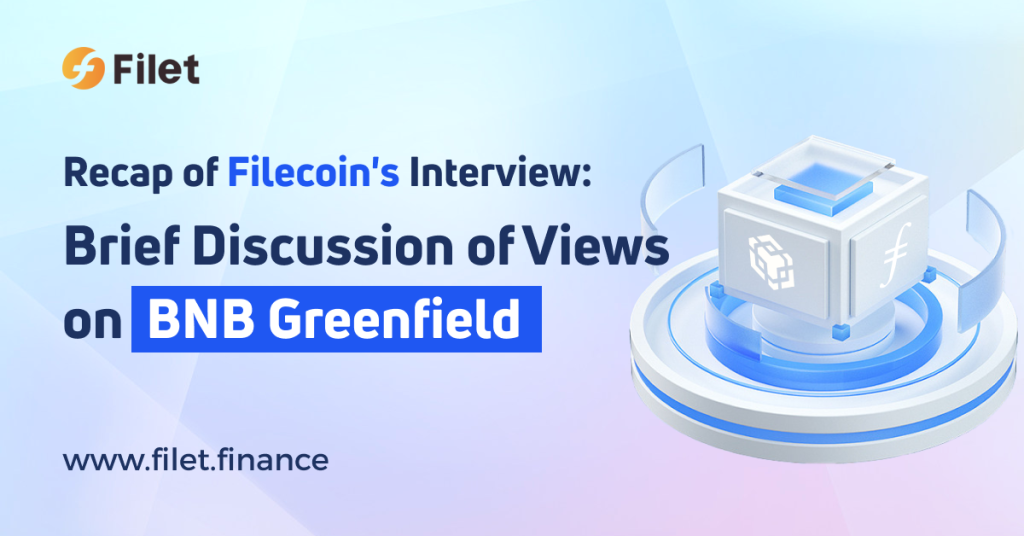
The BNB Chain, a blockchain platform launched by Binance, has released a white paper on a blockchain-based Web3 infrastructure called BNB Greenfield recently, which will allow users to store data on a distributed network and access or monetize it via smart contracts.
The release of the BNB Greenfield white paper not only ushers in new competition for existing projects in the storage industry but also injects a new paradigm into the development of the industry. Recently, Filecoin officials received media interviews. Let’s review their comments on BNB Greenfield.
Question 1: What kind of scale has decentralized storage developed to, or what kind of technological breakthroughs have been achieved to achieve large-scale applications?
Filecoin: The development of technology will inevitably face some difficulties. Taking Filecoin as an example, its technology combines the consensus incentive mechanism with the acquisition of hard disk resources for the network, making the Filecoin model the only one that can reach the Internet level. This has led to Filecoin’s protocol focusing on the bottom layer (between users and storage providers), which is different from what most developers want, and it cannot satisfy the ideas of some enterprises that want to simply apply solutions. However, the shortcomings of the technology will be filled by some new technical solutions, such as Estuary, Lighthouse, Web3.Storage, etc.
The current development of the industry, including the development of Filecoin, is at an early stage. Just as we have done with electric vehicles, we have to put into perspective the technology trajectory of the storage industry. Technology is constantly improving. Taking Filecoin as an example, with the introduction of modular services and the optimization of the proof mechanism, the cost of using its network has been significantly reduced. And as the network becomes more and more powerful, such as the launch of the CDN network (Filecoin Saturn), data computing framework (Bacalhau), and smart contract programmability, we will see more and more use cases that can be supported by decentralized infrastructure. The large-scale application of these technologies requires a process.
Question 2: Binance’s launch of BNB Greenfield, what is the significance for the storage track? What innovations have you seen in BNB Greenfield?
Filecoin: After reading BNB Greenfield’s white paper, one can see that its content is a good illustration of the data economy and the importance of combining Internet infrastructure primitives with programmability. For those who are bullish on games and NFTs, it is natural to want to control the services that run these infrastructures through smart contracts and use DeFi to create capital efficiency when using these functions.
Some of their technical actions are designed for Web2 users, such as introducing Web2 users through an S3 model (simple storage service)-a familiar experience to lower the barriers to entry.
The most important thing is BNB Greenfield’s discussion on the importance of various elements in the Web3 infrastructure: First, one of the core beliefs of ecology is that content addressing (such as IPFS) is very important. The reason why it is important is that to build an Internet where data will not be locked on a specific computer, a non-tamperable reference method is required, which allows your application to retrieve data from any storage network, user device, and CDN network. In the bucket’s mode, they focus on using the bucket’s internal identity (meaning that the reference identity is generated by each node); however, it might be better if they used CID identification mode.
Second, the permissionless nature is important for these networks. This requires solving harder problems first – but as these are solved, you can get a protocol with greater growth potential than any single or combined provider. A good example is Filecoin Saturn, an upcoming CDN network. Although it’s only in alpha, it already has 1,253 points of presence, which is about a quarter the size of market leader Akamai. Because any node can participate, this network can expand faster and larger than traditional web2 companies. In this instance, we have thousands of independent operators supporting the CDN network, rather than a single company.
Third, the verifiability and assurance of data integrity are very important for the combination of storage and other services: verifiability is an important property – it affects composability with other services (especially those involving value transfer Serve).
Question 3: Does Web2 need decentralized storage?
Filecoin: We believe that in the long run, the Web2 infrastructure will be completely migrated to Web3. This is not based on our philosophical views, but because migrating to Web3 can build low-cost, composable, and high-performance systems.
To achieve this end state, we need to reduce the cost of decentralization (such as Filecoin’s proof mechanism, tool friction, etc.) operability, and robust assurance mechanisms, etc.). As more and more tools make it easier to interact with Web3, and corresponding services are also launched (retrieval, data calculation, etc.), we can gradually replace the features that users need in traditional cloud services. Once our service is available, it can meaningfully compete with traditional cloud storage services.
Question 4: For large companies, what is the driving force for them to store data in a decentralized manner? The demand for decentralization seems to be only for individuals.
Filecoin: The rapid growth and use of Internet content require a better way to store data. Web3 can provide a more efficient and privacy-conscious solution. When using traditional storage infrastructure, most organizations will deal with service providers using the Web2 model, such as Amazon, Microsoft, Google, and Alibaba, and rely on these third parties to store and retrieve data, provide them with security and countermeasures. Risk of data failure and unavailability. The Web3 model can provide significant benefits to institutions using traditional cloud storage services: reduce storage costs, increase data availability, verify data storage, understand the carbon footprint of storage nodes, meet regulatory requirements, and support application development.
In addition, unlike Web2 cloud storage service providers, such services based on Web3 services can ensure data integrity, avoid data being locked by a service provider, and allow users to specify the data storage location to achieve data autonomy requirements. In this ecosystem, organizations do not need to be limited by the service levels of public cloud providers but can use storage networks running the same open-source framework to store their own data.
Question 5: There are many negative voices about Filecoin in the circle, such as “the requirements for mining hardware are high, there is too much garbage data on the network, and the performance and download speed are not good.” What do you think of these voices? And this storage How should the problem be dealt with?
Filecoin: Filecoin’s proof mechanism needs to consume more resources, but this is also the reason why we can expand the hard disk capacity of the network to such a large scale. There is currently some research trying to reduce these requirements, including sealing/snarks-as-a-service (sealing/snarks-as-a-service), which enables storage providers to outsource expensive computational steps to third-party marketplaces. These features can greatly reduce operating costs and lower the entry barrier for new storage providers entering the network.
In general, we believe that storage networking is still in its early days, and we’re only scratching the surface of what these networks can achieve. Storage is just one component – as we roll out compute, retrieval networking, and programmability, we’ll also see new applications that cannot be built on traditional Web2 models and new features that are more competitive with traditional rivals (in cold storage use case).
About Filet Finance
Filet is a Filecoin mining power tokenization protocol that deployed on Filecoin and BSC networks. It tokenizes Filecoin mining power and introduces it into the DeFi ecosystem to provide FIL holders with high-growth FIL staking services. The mining power and assets are completely open and transparent.
Filet is backed by one of the largest storage providers in North America. The project is open source and audited by Certik. It is safe and secure to stake in Filet. As for now, Filet is one of the Filecoin ecosystem projects.
Webiste: www.filet.finance
Telegram: https://t.me/filet_finance
Twitter: https://twitter.com/Filet_finance
Medium: https://filet.medium.com/
Email: contact@filet.finance
